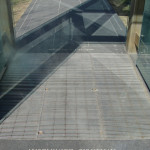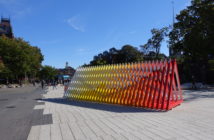In the heart of Boston, the New England Holocaust Memorial has stood quietly since 1995. On the Freedom Trail, adjacent to Boston City Hall, and near Faneuil Hall, this memorial is virtually unavoidable by Bostonians and tourists alike. While it is already an important public structure in the cityscape, today, on Holocaust Remembrance Day, this site takes on added significance.
The memorial, design by Stanley Saitowitz, is comprised of six striking glass towers, representing the six death camps, and on those towers a listing of six million numbers, representing the six million Jews who died in those camps. Etched on the glass towers that rise up fifty-four feet, these numbers recall the notorious tattoos on Holocaust victim’s arms. At a distance, the numbers are hardly visible, but as visitors walk through the memorial, they are confronted with the incredible scale of the Holocaust, and the incomprehensible number of victims.
The strength of the New England Holocaust memorial lies in its ability to represent each victim individually. Many Holocaust Memorials feature purely abstract architecture and cannot capture the specificity of the historic events. For instance, the Memorial to the Murdered Jews of Europe in Berlin has faced criticism that visitors can leave without even being able to identify the event being commemorated. Abstract memorials can create a powerful viewer experience, as the isolating, claustrophobic Berlin memorial does, but a crucial educational component is missing.
The numbering at the New England Holocaust Memorial creates a one-to-one relationship between victim and representation, echoing the listing of individual victims in Maya Lin’s Vietnam Veterans Memorial Wall in Washington, DC. Viewers are thus forced to confront the Holocaust on a personal level. Adding to a focus on the individual, the glass towers of the New England Holocaust Memorial also feature quotations from survivors that provide historic information as well as many unique points of view.
The focus on honoring each victim, at the New England Holocaust Memorial and at other sites, is crucial as the numbers and collective suffering of the Holocaust continue to astound. Most recently, a New York Times article asserted that Holocaust scholars themselves were shocked when new research revealed that the Nazis ran 30,000 slave labor camps from 1938-1945.
- Photo courtesy of Rob Young, via Flickr/Creative Commons
- Photo courtesy of Ben Sutherland, via Flickr/Creative Commons
- Photo courtesy of Ben Sutherland, via Flickr/Creative Commons







